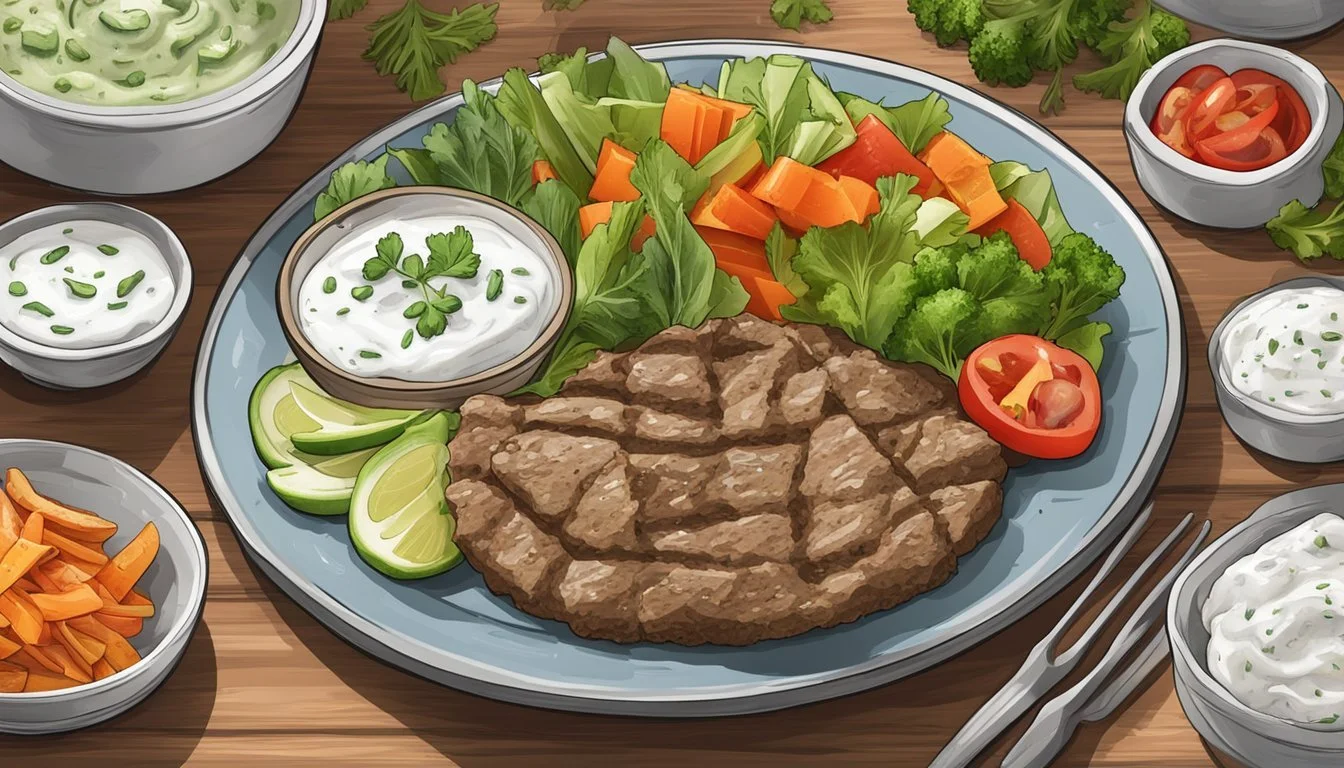How to Reheat Gluten-Free Gyro Meat
Expert Tips for Perfect Results
Reheating gluten-free gyro meat can be a simple and satisfying process. The key to maintaining its flavor and texture lies in using the right methods and heat levels. For a quick and effective approach, consider warming your gyro meat in a skillet with a tablespoon of cooking oil on medium heat, frying it for about 40 seconds. This method ensures your meat remains juicy and flavorful without compromising its gluten-free integrity.
Another effective way to reheat gluten-free gyro meat is by using the oven. Preheat your oven to 350°F (175°C), wrap the meat in aluminum foil, and place it in the oven for around 5-7 minutes. This method helps to evenly distribute heat and avoid any overcooking or hot spots, ensuring each slice of meat remains tender.
For those preferring the microwave, placing the meat on a microwave-safe plate with paper towels beneath and on top can prevent sogginess. Setting the microwave to medium-high power (around 70%) and heating for 1-2 minutes, depending on the meat's size and thickness, can offer a quick and easy solution. These methods provide versatile options to enjoy your leftover gluten-free gyro meat without sacrificing taste and texture.
Understanding Gyro Meat
Gyro meat, a staple of Mediterranean cuisine, is renowned for its flavorful combination of herbs and seasonings, often featuring a mix of lamb, beef, or chicken. This section delves into the rich history and traditional ingredients that make gyro meat a beloved choice for many.
History of Gyro and Its Cultural Significance
Gyro meat has its roots in Greece and has become a popular street food around the world. The term "gyro" comes from the Greek word for "turn" due to the method of cooking the meat on a vertical rotisserie.
Originally, lamb and beef were the primary meats used, but variations now include pork and chicken. The recipe is strongly influenced by the Turkish doner kebab and the Middle Eastern shawarma.
The vertical rotisserie allows the meat to cook evenly and retain its juices, resulting in a tender and flavorful dish. Over the years, gyro has transcended its street food status to become a popular option in restaurants globally.
Traditional Ingredients in Gyro Meat
Traditional gyro meat is typically made from a mixture of lamb and beef, though chicken and pork are also common. Homemade gyro meat often includes ground lamb and ground beef, combined with a variety of spices and herbs.
Key seasonings include dried marjoram, oregano, rosemary, thyme, cumin, garlic powder, and onion mixture. These seasonings give the meat its distinctive taste that is both savory and aromatic.
The process involves blending ground meats with the herbs and spices, then cooking on a vertical rotisserie. This method ensures that the meat slices remain flavorful and moist, delivering the iconic taste that is synonymous with Mediterranean street food.
Gluten-Free Considerations
When preparing gluten-free gyro meat, it's crucial to select appropriate ingredients and methods. This section covers the key aspects of choosing suitable gyro meat, alternative gluten-free ingredients, and making gyro meat at home.
Choosing Gluten-Free Gyro Meat
Selecting meats guaranteed to be gluten-free is essential for a safe dining experience. Many homemade gyro recipes are naturally gluten-free, and some brands offer pre-made gluten-free options.
Check labels carefully for potential additives like breadcrumbs or wheat-based stabilizers. It's best to opt for brands that explicitly state their product is gluten-free.
Alternative Ingredients for Gluten-Free Cooking
Using gluten-free alternatives ensures dishes remain safe for those with gluten sensitivities. Elements like rice flour and gluten-free breadcrumbs can replace traditional components in marinades or coatings.
Bread Options:
Gluten-free pita bread
These alternatives mimic traditional accompaniments and maintain the meal's integrity.
Homemade Gluten-Free Gyro Meat
Making gyro meat at home guarantees control over ingredients. Start by using top-quality meat and seasoning blends. Mince the meat mixture with a food processor, and use breadcrumbs made from gluten-free bread to bind it.
Form the meat into a meatloaf pan and weigh it down using a heavy object wrapped in foil. Refrigerate for a few hours, then bake. Serve with gluten-free flatbreads and a cucumber-based tzatziki sauce.
Pre-Reheating Preparation
Optimal pre-reheating preparation ensures that gluten-free gyro meat retains its flavor and texture. Key steps include following safety measures, marinating for better taste, and portioning appropriately.
Safety Measures and Best Practices
Begin by verifying the quality of the gyro meat. Ensure it is stored in the fridge at a safe temperature. Use a meat thermometer to confirm the internal temperature stays below 40°F (4°C).
When preparing for reheating, follow these safety steps:
Wash hands and surfaces thoroughly.
Use clean utensils and a mixing bowl.
Avoid cross-contamination by keeping meats separate from other foods.
Ensure leftovers are not older than three days to maintain safety and flavor.
Marinating and Seasoning for Enhanced Flavor
Enhance the taste by marinating the gyro meat. Prepare a marinade using ingredients like olive oil, garlic, black pepper, and lemon juice. Combine these in a mixing bowl and blend well.
Add meat slices to the bowl.
Toss to coat evenly.
Allow the meat to marinate for at least 30 minutes in the fridge.
Marinating can re-introduce moisture and flavors that might have been lost during initial cooking.
Portioning and Wrapping for Reheating
Proper portioning simplifies the reheating process. Weigh the meat to ensure equal portions. Divide it into manageable sizes, depending on how much you plan to reheat at once.
To wrap gyro meat:
Use foil or parchment paper.
Place meat on the wrapping surface.
Wrap each portion tightly to retain moisture.
Label with the date for easy tracking.
Once portioned and wrapped, store the meat on a cooling rack within the fridge until ready for reheating. This prevents excess moisture buildup and ensures the meat reheats evenly.
Reheating Methods
Reheating gluten-free gyro meat can be done effectively using an oven for even heating or a skillet for a crispier texture. These methods ensure the meat retains its flavor and avoid any soggy results.
Oven Reheating Instructions
To reheat gluten-free gyro meat in the oven, start by preheating the oven to 350°F (175°C). Arrange the gyro meat in a single layer on a baking sheet lined with parchment paper or foil to prevent sticking. Cover the meat with aluminum foil to help retain moisture. Bake for approximately 10-15 minutes until the meat is warmed through.
For a more crisp finish, uncover the foil for the last few minutes of reheating. Ensure that the meat is not overcrowded on the baking sheet to allow for even heating. This method is ideal for cooking large batches without overcooking any pieces.
Skillet Technique for a Crispier Texture
To achieve a crispier texture, a skillet is an excellent choice. Start by heating a tablespoon of cooking oil in a skillet over medium heat. Once the skillet is hot, add the gyro meat in a single layer.
Cook and sear the meat for about 20 seconds on each side, stirring occasionally to ensure even heating and to prevent burning. This method is quick, and searing in the skillet gives the gyro meat a delicious, crispy finish while maintaining its tender inside.
For larger portions, reheat the meat in batches to avoid crowding the skillet, which can lead to uneven cooking and sogginess.
Serving Suggestions
Enhance your gluten-free gyro meat by pairing it with delicious sides and assembling your gyro with care.
Making the Perfect Side Dishes
To complement the rich flavors of the gyro meat, consider serving homemade tzatziki sauce. This yogurt-based sauce, infused with dill, mint, and a hint of cider vinegar, adds a refreshing touch. Greek salad is another excellent side, comprising sliced cucumbers, tomatoes, red onions, and crumbled feta cheese, dressed with olive oil and lemon juice.
For more texture, offer roasted vegetables like bell peppers and zucchini, seasoned with olive oil, garlic, and herbs. Gluten-free pita chips also make for a great side dish, ideal for dipping into the tzatziki.
Assembling a Gluten-Free Gyro
When assembling a gluten-free gyro, start with warm gluten-free pita bread or flatbread. Layer a generous serving of the reheated gyro meat on top. Add a dollop of tzatziki sauce, ensuring it spreads evenly.
Next, add fresh lettuce, sliced tomatoes, cucumbers, and thinly sliced red onions for crunch and flavor. Optionally, sprinkle some crumbled feta cheese for an extra savory punch. Roll or fold the pita, securing the ingredients inside for a convenient and delicious gyro experience.
Storage Tips for Leftovers
Proper storage of leftover gluten-free gyro meat ensures it remains fresh and safe for later consumption. Effective cooling and airtight packaging are crucial components of this process.
Proper Cooling and Air-Tight Packaging
Proper Cooling: Allow the gyro meat to cool down to room temperature before placing it in the fridge. This prevents condensation and reduces the risk of bacterial growth. Usually, this takes about 30 minutes. Make sure to avoid leaving the meat out for more than 2 hours.
Air-Tight Packaging: Use parchment paper or foil to wrap individual portions of the gyro meat. This can help maintain its moisture. For additional protection, place the wrapped meat in an airtight container or a resealable plastic bag. Proper sealing helps to prevent air exposure, which could lead to freezer burn or drying out.





